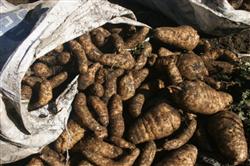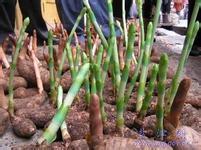Standardized cultivation techniques of Gastrodia elata
Gastrodia elata, also known as Dingfeng grass, is an orchid plant and is a valuable traditional Chinese medicine in China. Tuber is used as medicine, which is beneficial to relieving spasm, calming the liver and relieving wind, fixing shock and dispelling dampness. It can treat dizziness, limb numbness, epilepsy, infantile convulsion, hypertension, otogenic vertigo and so on. Gastrodia elata is mainly produced in Guizhou, Yunnan, Sichuan and Guangxi. There are still trial species in the north and northwest of Guangdong. 1. Ecological characteristics 1. The relationship between the growth of Gastrodia elata and Armillaria mellea Gastrodia elata is a strange plant without roots and green leaves, its tuber sneaks into the soil all the year round and can not carry out photosynthesis. Because it does not directly receive soil nutrition and produce nutrients, it mainly relies on a wild fungus called Armillaria mellea to provide nutrition in order to grow, develop and reproduce normally. Therefore, the cultivation of Armillaria mellea is the primary work of cultivating Gastrodia elata. 2. Growth characteristics of Armillaria mellea Armillaria mellea is a saprophytic fungus of Armillaria mellea. In alpine forests, wild Armillaria mellea often grows on the stumps, roots and fallen trunks and branches, especially in the moist places on both sides of the gully, so there are wild Armillaria mellea in all places where wild Gastrodia elata grows. Armillaria mellea likes to grow in the slightly acidic soil zone of ph5 5-6. The developmental stage of Armillaria mellea can be divided into two parts: mycelium and fruiting body. 3. The growth environment of Gastrodia elata. Most of the wild Gastrodia elata grows in a cool environment in summer, with an altitude of 1000 ℃ 1800m, annual rainfall of 1400Mel 1600mm, air relative humidity of 80% MUE 90%, soil moisture of 50% MUE 70%, and a temperature of no more than 25 Mel. The production practice has proved that the artificial planting of Gastrodia elata can be carried out in the area with an altitude of 800m and 1800m, but it is more suitable at an altitude of 1100m and 1600m. If the soil temperature and humidity can be controlled manually, Gastrodia elata can also be planted in low altitude Pingba area and indoor, as well as in basement and air-raid shelter. Gastrodia elata likes to grow in the slightly acidic soil with loose, more humus and good air permeability. Grow poorly in clay (such as wet yellow mud). 2. Cultivation techniques 1. According to the cool characteristics of Gastrodia elata, in high mountain areas above 1500 meters above sea level, sunny slopes with low temperature and high humidity should be selected; in low mountain areas below 1000 meters above sea level, the temperature is generally high and dry, especially in summer and autumn, continuous high temperature and drought occurs, and shady or semi-shady slopes should be selected. In the area between 1100m and 1600m above sea level, the temperature and humidity are usually between high and low mountain areas. According to the local climate, it is appropriate to choose sparse forest slopes that are half shady and half sunny. Gastrodia elata is not very strict on soil, but it is suitable for sandy gravel soil and sandy loam, which is deep, rich in humus, loose and fertile, and well drained. Gastrodia elata has a great demand for soil moisture, and it is generally necessary to maintain more than 50% humidity all the year round, but the waterlogged waterlogged land that is too wet is not conducive to its growth. For the requirements of land preparation, as long as the ground is too dense miscellaneous trees, bamboo groves or remove large stones, clear the soil and stone dregs, weeds, you can directly dig holes or trenches to plant. 2. The propagation methods include seed propagation and tuber propagation. At present, tuber propagation is mainly used in production. However, no matter using seed propagation or tuber propagation, according to the characteristic that Gastrodia elata must symbiosis with Armillaria mellea in order to obtain cell nutrition for reproduction and growth, so cultivated Gastrodia elata should first cultivate Armillaria mellea on wood (wood stick), that is, cultivate fungus, and then cultivate. (1) cultivated fungus material, which refers to the wood with Armillaria mellea. The source of ① preparation strains can be considered from several aspects: first, the collection of natural wild strains; second, the use of effective old bacterial materials that have been planted with Gastrodia elata; third, outdoor culture of new strains; fourth, indoor culture of pure bacterial materials. There are many tree species that can grow Armillaria mellea in wood selected by ②, which are generally used in broad-leaved forest. According to the local experience, the commonly used tree species are: mistletoe oak, cork oak, Chinese chestnut, green bar walnut, maple poplar, wax gourd poplar, Fatong, wild cherry, catalpa and other trees. ③ can be cultured outdoors from March to August. It is usually better before the trunk begins to grow from March to April. When the fungus was cultured from June to August, the soil temperature was high and Armillaria mellea grew fast, which could relatively shorten the cultivation time and maintain sufficient nutrients, but attention should be paid to avoid miscellaneous bacteria infection. After September, the temperature dropped and Armillaria mellea grew slowly, so it could not be used in that year and should not be carried out. If the conditions are suitable for the cultivation of bacterial materials in the four seasons, they can be cultivated 2-4 months before Gastrodia elata is planted. The cultivation methods of ④ fungus include pile culture, kiln culture and fixed fungus culture. Compared with the latter, the first two methods are also called active fungus culture. When planting Gastrodia elata, the cultivated fungus material can be taken at will. Stacking method: choose the place close to the cultivation of Gastrodia elata, spread the prepared new wood on the ground one by one, and the width of the fungus pile is about 60 cm. After the first layer is paved, sprinkle clean water on it, and evenly lay the seed material that has been cultivated without miscellaneous bacteria. If the strain is not enough, put 2 small pieces of seed wood every two segments of wood, and sprinkle a small amount of litter or rice husk fragments as fillers, and then spread the second layer of wood to add seed materials and fillers, so repeat layer by layer stacking layer by layer, can be paved with 5 lines of 6 layers, stacked to about 60 cm high. Kiln cultivation method: can be dug in the forest glades or other bare land to make a kiln, its size depends on the topography and the number of cultured bacterial materials, generally a kiln culture 150Me 200 is appropriate, should not be too much. (2) planting Gastrodia elata ① asexual propagation cultivation method using the tuber of Gastrodia elata as propagation material is called asexual cultivation. ② active fungus material plus new material companion planting method digs the kiln according to the specific conditions of the planting site, the kiln width is 6ml 8cm wider than the length of the fungus, and the length of the kiln is variable, so it is appropriate to release 20 pieces of fungus; the depth of the kiln should be adjusted to local conditions, the bottom of the kiln should be dug into a slope shape, and then the fungus can be laid and Gastrodia elata can be planted. ③ sexual reproduction method the planting method of using seeds as reproductive material is called sexual reproduction cultivation. Using white-headed hemp and rice flax produced by seed reproduction as seed flax has strong vitality, not easy to degenerate, and high reproduction coefficient, which is an important way to cultivate Gastrodia elata.
- Prev

Matters needing attention in Gastrodia elata harvest
⑴ be careful not to damage the flax body when digging, you should carefully remove the surface culture material, remove the bacterial material, gently take out Gastrodia elata, and be careful not to damage the flax body, especially the white flax and rice hemp used for seed. ⑵ carefully harvest and pay attention to look around, can not be ignored and missed Gastrodia elata. Due to the growth and development of Armillaria mellea around.
- Next

Cultivation method of substitute material for Gastrodia elata at low altitude
Gastrodia elata is a kind of rare and precious traditional Chinese medicine, which used to rely on the wild and grow in the mountains above 500 meters above sea level. it is very rare and difficult to dig, and now it is facing extinction. The development of artificial cultivation of Gastrodia elata has saved this precious species, but technically it can not get rid of the cultivation at high altitude, and the raw materials are also inseparable from Duan Mu.
Related
- Fuxing push coffee new agricultural production and marketing class: lack of small-scale processing plants
- Jujube rice field leisure farm deep ploughing Yilan for five years to create a space for organic food and play
- Nongyu Farm-A trial of organic papaya for brave women with advanced technology
- Four points for attention in the prevention and control of diseases and insect pests of edible fungi
- How to add nutrient solution to Edible Fungi
- Is there any good way to control edible fungus mites?
- Open Inoculation Technology of Edible Fungi
- Is there any clever way to use fertilizer for edible fungus in winter?
- What agents are used to kill the pathogens of edible fungi in the mushroom shed?
- Rapid drying of Edible Fungi

